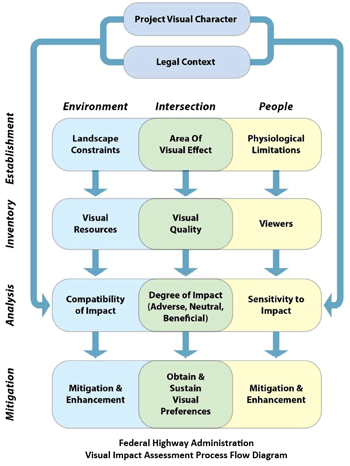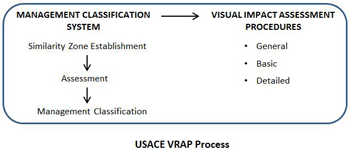Visual Impact Assessment Methodologies for Other Federal Agencies
This page describes visual impact assessment approaches for the Federal Highway Administration (FHWA), the U.S. Army Corps of Engineers (USACE), the Bureau of Ocean Energy Management (BOEM), the Federal Energy Regulatory Commission (FERC), and the Natural Resources Conservation Service (NRCS).
Federal Highway Administration
The FHWA supports transportation projects that are subject to environmental impact assessments that include visual impact Assessments (VIAs). FHWA's VIA procedure provides guidance to state departments of transportation, but is not mandatory. FHWA recently issued new VIA guidance entitled "Guidelines for the Visual Impact Assessment of Highway Projects" (2015, 104 pp). The Guidelines recommend specific procedures for conducting VIAs for highway projects. The VIA process is carried out in four phases: Establishment, Inventory, Analysis, and Mitigation. The process is shown in the figure.

Establishment Phase
The primary purpose of the establishment phase is to define the Area of Visual Effect (AVE), i.e., the study area of the VIA. The AVE is determined by considering the landscape constraints (landform and land cover) and the physiological limits of human sight. The VIA preparers also build an understanding of the conceptual character of the proposed project, including a rough understanding of the project's visual character, and determine if the community has any defined visual preferences.
Inventory Phase
The purpose of the inventory phase is to examine visual quality, or what people like or dislike seeing. The components of the affected environment within the AVE and the composition of the affected population are identified, and the relationship between them is considered. More information about visual resource inventories can be found in the Visual Resource Inventory section of this website. The FHWA inventory process is discussed in Chapter 5 of the Guide, and is summarized under Visual Resource Inventories: Other Federal Agencies.
Analysis Phase
The purpose of the analysis phase is to evaluate impacts on visual quality. The VIA preparers assess impacts the project may cause to visual resources and viewers separately, and then synthesize these separate evaluations and describe the degree of impact as beneficial, adverse, or neutral.
Mitigation Phase
In the mitigation phase, the mitigation and enhancement efforts to be included in project design are defined. This final phase of the VIA process is typically completed after a preferred alternative has been selected. More information about visual impact mitigation can be found in the Visual Impact Mitigation section of this website. FHWA mitigation recommendations are discussed in Chapter 7 of the Guide, and are summarized under Visual Impact Mitigation: Other Federal Agencies .
U.S. Army Corps of Engineers
The USACE authorizes water resource projects, such as dam construction and operation, that may sometimes result in major visual impacts. USACE's Visual Resources Assessment Procedure (VRAP) is a systematic method to (1) evaluate and classify existing visual quality; (2) assess and measure visual impacts caused by Corps projects; (3) evaluate visual impacts; and (4) make recommendations for changes in plans, designs, and operations of the projects. The VRAP is presented in the USACE Instruction Report EL-88-1, "Visual Resources Assessment Procedure for US Army Corps of Engineers" (Issued 1988, 97 pp).
Management Classification System
As shown in the figure below, VRAP is composed of two parts, the Management Classification System (MCS) and the Visual Impact Assessment (VIA) Procedures. The MCS establishes an Assessment Framework for a project area and sets the visual resource criteria that are used throughout the visual assessment. The existing visual quality of an area is determined by inventorying the visual resources and comparing the inventory with the Assessment Framework. More information about visual resource inventories can be found in the Visual Resource Inventory section of this website. The VRAP inventory process is discussed in Part II of the VRAP report, and is summarized under Visual Resource Inventories: Other Federal Agencies.

Visual Impact Assessment Procedures
The VRAP recognizes three levels of VIA:
- General VIA Procedures used in early or preliminary studies to assess general study areas and preliminary plans;
- The Basic Procedure, which provides the impact assessment and evaluation information required for most Corps studies; and
- The Detailed Procedure, which permits a more sensitive and extensive VIA by adding an inventory and assessment of design elements, i.e., form, line, color, and texture.
The choice of which VIA method to use is based on the characteristics of the proposed project, visual sensitivity of the potentially affected area, time constraints on the analysis, and availability of data and resources.
All three VRAP VIA process include a project-level inventory of scenic resources. After a site-specific inventory of visual resources, using the proposed alternatives, the VRAP measures the change in the visual resources and determines the compatibility or acceptability of the changes in the visual resources, i.e., the visual impact. Visual simulations of the with- and without-project conditions are used to determine changes in visual resources. The MCS criteria are used to determine the acceptability or compatibility of the visual impacts.
The VRAP uses the Management Class to determine the degree and type of visual change that is acceptable. See the Visual Resource Inventories: Other Federal Agencies page of this website for more information about VRAP Management Classes. For VIA, the assessment framework is used to assign levels of visual quality (distinct, average, or minimal) to the landscape components (water resources, landform, vegetation, land use, and user activity) of the forecast conditions with and without the project. In addition, ratings are given for three compatibility modifiers (compatibility, scale contrast, and spatial dominance) and the presence of special conditions. A numerical VIA value representing the degree of visual impact is compared to the level of visual impact that is acceptable within the management classification.
For the Basic Process, visual simulations of the proposed project, as it would be seen from designated viewpoints that are representative of the areas are used as a partial basis for judging the likely visual impact of the proposed project. The impact assessment includes a "without-project" forecast, i.e., and assessment that assumes the project is not built. This assessment is compared to the assessment that assumes the project is built (the "with-project" forecast). Using the simulations to compare the "without-project" forecast to the "with-project" forecast, professional judgment is used to determine the visual impact of the project.
The Detailed Process is similar to the Basic Process but uses additional descriptors in the project-level inventory — the design elements of form, line, color, texture, and scale — on both the "with project" and "without project" forecasts. The differences in the design elements between the two forecasts are then incorporated into the assessment of impacts.
Bureau of Ocean Energy Management
The Department of the Interior's Bureau of Ocean Energy Management (BOEM) Office of Renewable Energy Programs (OREP) is responsible for offshore renewable energy development in Federal waters and anticipates future development on the Outer Continental Shelf from three general sources: offshore wind energy, ocean wave energy, and current wave energy. In particular, offshore wind energy development has the potential to introduce new visual elements into aesthetic land- and marine-scapes and alter the setting of historic properties potentially eligible for the National Register.
BOEM's federal regulatory authority to approve, approve with modification, or disprove the construction of offshore renewable energy facilities also establishes BOEM's responsibility to assess the visual impacts caused by these facilities and incorporate the results of such assessments into its overarching National Environmental Policy Act and National Historic Preservation Act Section 106 reviews. In anticipation of receiving Construction and Operations Plans, OREP is presently developing (1) a Visual Impact Assessment methodology for the purposes of establishing a consistent and scientifically-based VIA process for renewable energy facilities on the outer continental shelf; and (2) a set of draft guidelines for BOEM to provide to developers to guide them in preparing the necessary elements of the VIA that would need to be submitted to support their COPs. BOEM anticipates that this methodology and guidelines will be made available in September 2017.
Additionally, BOEM has sponsored visual impact-related projects and research, including simulations of visual impacts from offshore wind facilities, an analysis of visibility of offshore wind turbines, and development of an in-house GIS-based tool to support assessment of potential visual impacts associated with offshore wind energy facilities.
Federal Energy Regulatory Commission
The Federal Energy Regulatory Commission (FERC) does not have formalized visual resources policies, programs, or documents. However, the Federal Power Act and the Commission's regulations are used by staff to analyze the effects of energy facilities on visual resources, on a case-by-case basis. The Division of Gas Environment and Engineering staff use 18 C.F.R. § 380.15 (2015) to analyze the effects on visual resources. The regulation requires that the siting, construction, and maintenance of facilities shall be undertaken in a way that avoids or minimizes effects on scenic, historic, wildlife, and recreational values.
The Division of Hydropower Licensing staff use, as appropriate, the Federal Power Act, 16 U.S.C. §§797(4)(e) (2012) and/or 16 U.S.C. §§803(10)(a) (2012) to analyze the effects of energy facilities on visual resources. Also, 18 C.F.R. § 4.41(f)(8) (2015) requires that hydropower license application for a major unconstructed project or a major modified project contains a report on aesthetic resources. The license applicant must provide a report that describes the aesthetic resources of the proposed project area, the expected impacts of the project on these resources, and the mitigation, enhancement or protection measures proposed.
For a hydropower license application for a major project - existing dam, 18 C.F.R. § 4.51(f)(6) (2015) requires that the license applicant provide a report on land management and aesthetics. The report must discuss the management of land within the proposed project boundary, including wetlands and floodplains, and the protection of the recreational and scenic values of the project. For a hydropower license application for a minor water power project and major water power projects 5 megawatts or less, 18 C.F.R. § 4.61(d)(2)(i) (2015) requires that the license applicant provide an environmental report that contains a description, including any maps or photographs which the applicant considers appropriate, of the environmental setting of the project, including vegetative cover, fish and wildlife resources, water quality and quantity, land and water uses, recreational uses, historical and archeological resources, and scenic and aesthetic resources.
For hydropower license applications using the Integrated Licensing Process, 18 C.F.R. § 5.6(d)(3)(ix) requires that the license applicant provide in its Pre-Application document a description of the visual characteristics of the lands and waters affected by the project. Components of this description include a description of the dam, natural water features, and other scenic attractions of the project and surrounding vicinity. Potential applicants are encouraged to supplement the text description with visual aids.
Also, for hydropower license applications using the Integrated Licensing Process, 18 C.F.R. § 5.18(b)(5)(ii)(A) requires that the license applicant provide a detailed description of the affected environment or area(s) to be affected by the proposed project by each resource area. This description must include the information on the affected environment filed in the Pre-Application Document provided for in 18 C.F.R. § 5.6, developed under the applicant's approved study plan, and otherwise developed or obtained by the applicant.
National Resource Conservation Service
The National Resource Conservation Service (NRCS) assists owners of privately owned agricultural and rural lands, and does not work on public lands. NRCS does not currently have an agency-wide visual resource policy or program, but has developed Web-based guidance for conducting visual quality inventories and for incorporating visual resource concerns into agency activities. Some of this guidance deals with visual impact simulation and other visual impact-related topics. The NRCS Technical Release TR-65 “Procedure to Establish Priorities in Landscape Architecture” (1978, 20 pp) is used by NRCS's non-landscape architect field staff to quickly determine visual impact levels that NRCS conservation programs might cause on agricultural landscapes. If the TR-65 survey indicates a "High Priority Area", field personnel are to request professional LA assistance to investigate all proposed impacts and develop design changes and mitigation strategies.